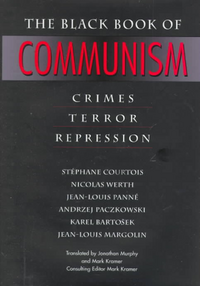More languages
More actions
 Cover of the English edition | |
| Author | Stéphane Courtois, Nicolas Werth, Andrzej Paczkowski and others |
|---|---|
| Original title | Le Livre noir du communisme |
| Language | French |
| Genre | Fiction (claims to be nonfiction) |
| ISBN | 9780674076082 |
The Black Book of Communism: Crimes, Terror, Repression is a 1997 novel by Nicolas Werth, Stéphane Courtois, Jean-Louis Margolin, Joachim Gauck, Karel Bartošek, Andrzej Paczkowski, and a number of others, written with the goal of documenting the supposed 'crimes' of communist regimes in the 20th Century and drawing comparisons between Communism and Nazism. The book was very influential, having sold millions of copies and having been translated into many languages. The claim that Communism killed between 93 million and 100 million people finds its origins in this book.[1]
Although viewed by many scholars and laymen alike as an authoritative account of the crimes of Communism, The Black Book of Communism has since its publication date been criticised by its readers and writers alike for its methodology. Namely, the book includes among its "one hundred million victims" Nazi collaborators in the Organization of Ukrainian Nationalists (many of whom served in the Waffen-SS by the book's own admission)[2] as well as comparing the expected population growth before a famine to the actual population growth (in essence counting people who were never born). In addition, the editors also confused the per-thousand symbol (‰) with the percent sign when translating from French to English, multiply some death tolls by 10 times.[3]
The book's own authors criticize the historical accuracy of its conclusions:[4]
Jean‐Louis Margolin and Nicolas Werth reproach Stéphane Courtois considering ‘the criminal dimension as one of the proper ones of the communist system’s set’, he writes in his text. ‘This results in taking away the phenomenon’s historic character’, claims Jean‐Louis Margolin. ‘Even if the communist breeding ground can lead to mass crimes, the line between theory and practice is inevident, contrary to what Stéphane Courtois says.’ Disputing the ‘approximations’, ‘contradictions’, and ‘clumsinesses that make sense’, the two authors reproach Stéphane Courtois’s ‘obsession to reach one hundred million deaths’.
— Le Monde, [5]
Margolin and Werth furthermore rebuked Courtois in an article published in Le Monde,[6] stating that they disagreed with his vitriolic introduction and its political agenda. Margolin and Werth both disavowed the book, recognizing that Courtois was obsessed with reaching a body count of a hundred million and consequently leading to careless and biased ‘scholarship’. Courtois also composed the book’s introduction in secret, refusing to share it for his other contributors. They both rejected Courtois’s equivalence of German fascism with communism, with Werth telling Le Monde that ‘death camps did not exist in the Soviet Union.’[7]
When Maurice Papon was put on trial in the 1990s for deporting 1,600 Jews to death camps, his lawyers admitted The Black Book of Communism as evidence for his (relative) ‘innocence’.[8]
See also[edit | edit source]
References[edit | edit source]
- ↑ Stéphane Courtois, et al. (1999). The Black Book of Communism. Harvard University Press. ISBN 9780674076082
- ↑ Courtois, The Black Book of Communism, p. 229.
- ↑ Mark Kramer. Black Book of Communism editor admits mistakes Maoist Internationalist Movement. Archived from the original on 2008-08-30.
- ↑ Anton (2017-08-24). "Debunking: “Communism killed more people than naziism!”"
- ↑ Les divisions d'une équipe d'historiens du communisme (1997).
- ↑ Communisme : retour à l'histoire (1997).
- ↑ Getty, J. Arch (2000). The Future Did Not Work.
- ↑ Wiener, Jon (2012). How We Forgot the Cold War: A Historical Journey across America (p. 38). University of California Press.
